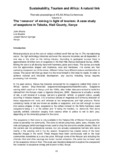| dc.description.abstract | Mineral products are at the core of today’s civilized world that we live in. The manufacturing sector, the high technology industries and even the resource industries are all dependent, in one way or the other on the mining industry. According to geological surveys there is approximately 22 billion tons of soapstone in the Kisii Hills (Kenya Geological Survey, 2008). Mining the stone is all done by hand with hammers, picks and chisels. The stones are made into the approximate shapes with machetes, axes and handsaws. The stones are then carried by manpower out of the mines. Different mines have different colours and densities of stones. The carver will often go down into the mine himself to find what he needs. In order to achieve national and industrial development, any country including Kenya requires processing their minerals.
In the past century, Kenya has become renowned for its soapstone (called Kisii stone in Africa) carvers (http://www.kisii soapstone/kisiisoapstones/kisiionline.com). Soapstone carving didn't catch on in Kenya until the 1940s, after Indian labourers arrived to build the railroad from the Kenyan coast to Uganda (Mong’are, 2006). Soapstone is actually a variety of talc, a soft mineral of a soapy feel and a greenish, whitish, or greyish colour, usually occurring in foliated masses. It is a hydrous silicate of magnesia and forms by alteration of these magnesium-rich rocks and minerals at low temperatures and high pressure. Rocks consisting mainly of talc are known as steatite or soapstone, and are soft enough to carve into various shapes. In fact, soapstone is the softest mineral on the Mohs hardness scale (soapstone being a 1, or the softest and 10 being the hardest, i.e. diamond). Kisii stone typically exhibits coloration ranging from creamy white to yellow to red to dark grey, depending on the mineral(s) present in the stone.
The soapstone in Kisii stone is only available in the Tabaka Hills of Western Kenya and the stone is carved by the community. The stone is mined using hoes, picks, axes, shovels, iron rods and pangas (which are large knives used to chop the stone into smaller pieces). Most of the carvers are not professional carvers, but are actually subsistence farmers who carve mainly in the evening and in the dry season. Soapstone has created some of the most beautiful images in the world. These images have been continuously sold to the local communities sometimes at a very low price. Although some of the Kenyan arts including the chiondo, kikoi and other carvings are instant tourism attraction, this same has not been said of the soapstone mines in Kisii. This study was therefore designed to explore the unexpected the ‘romance’ of soapstone mining and tourism in Kisii, Kenya. | en_US |

